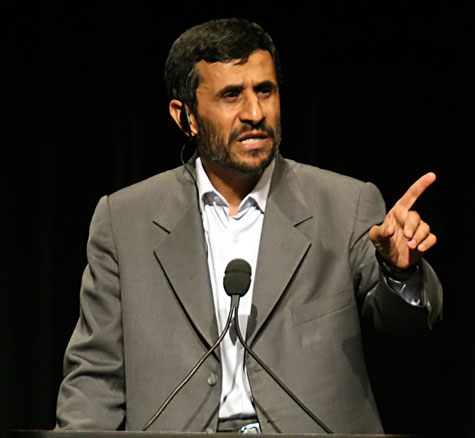Experts Weigh In on Obama’s Explanation of Iran’s Nuclear Facility
Several independent experts believe the facility is most likely being constructed to support a nuclear weapons program, though the White House’s explanation should be assessed carefully.
Jul 31, 2020293.2K Shares3.9M Views
Flanked by the French president and the British premier, President Obama on Friday dramatically stated that the “size and configuration” of a previously undisclosed Iranian nuclear facility near the clerical city of Qom make it “program, especially as Iran’s concealment of it comes after years of nondisclosure and obstruction of inspections. But even those experts believe that the “size and configuration” of the facility does not necessarily mean it could only be used to build an atomic bomb.
The facility in Qom, which is not yet completed, is significantly smaller than the enrichment facility at Natanz that has concerned the International Atomic Energy Agency since 2003. Natanz contains 50,000 centrifuges, compared to the 3,000 the administration believes to be at Qom. All that raises questions about the basic economic logic of constructing such a small facility to produce peaceful nuclear power.
Illustration by: Matt Mahurin
“If you have 50,000 [-centrifuge] facility, you don’t go to all the expense build a new facility to increase capacity by 6 percent,” said James Acton, a nuclear researcher at the Carnegie Endowment for International Peace. “None of this makes sense for an economic standpoint. What it does make sense for is a weapons standpoint.”
Yet that reasoning is inferential, not explicitly concluded from the “size and configuration” of the Qom facility. “It’s kind of hard to draw clear red lines about [centrifuge] numbers,” Acton cautioned. “Any facility is capable of producing any amount of uranium of any enrichment if it has time to do so.”
Added Ivanka Barzashka, a nuclear analyst with the Federation of American Scientists, “The size of a facility does not determine whether it can or cannot produce weapons-grade, or highly-enriched, uranium. Both enrichment to a low degree for a nuclear reactor and to a high degree for a nuclear weapon is done by gas centrifuges. In both cases, these are exactly the same machines.” The issue for Barzashka, like Acton, is that “certain things make economic sense and others don’t,” and building a 3,000-centrifuge facility to enrich uranium for nuclear power would most likely take ” about 90 years to get one years fuel load. This of course makes no sense.”
David Albright, the president of the Institute for Science and International Security, said he was confused by Obama’s statement. “Size doesn’t tell me anything,” said Albright, whose organization postedsatellite photographs of the facility’s exterior on Friday. “There’s no real hard and fast threshold” based on number of centrifuges that distinguishes a nuclear-weapons facility from a nuclear-energy facility. While one possibility for Qom is the production of a smaller facility for conducting nuclear research, Albright, like Acton, said that “I personally believe this is for a nuclear-weapons capability.”
Uranium used for a nuclear weapon must be enriched to a high potency, over 90 percent, through the use of centrifuges to separate out the fissionable isotopes. Centrifuges are arranged together in so-called cascades to achieve greater potency in less time. At the United Nations General Assembly, Iranian President Mahmoud Ahmadinejad said that Iran is interested in enriching uranium to about 20 percent, which could provide for nuclear energy but is far short of weapons-grade enrichment. Secretary of State Hillary Rodham Clinton said in an interviewaired Sunday on CBS’s “Face The Nation” that Iran “can’t say anything” to satisfy international concerns about Iran’s nuclear program after years of Iranian concealment and deception, but instead must “open up the entire system to extensive investigation” by the IAEA.
“If you wanted a facility to make enough low-enriched uranium for a power reactor you need a site like Natanz,” Albright continued, since fueling a nuclear-power reactor requires a large amount of enrichment. “You need about 50,000 centrifuges. But if you want [enriched uranium] for a bomb,” Albright said, then “3,000 is plenty**. **Two thousand would be enough. But you can’t reverse it and say if it’s small it can’t be used for civilian purposes.”
The small number of centrifuges at the facility, though, raises questions about how efficiently the Iranians could produce enough enriched uranium at Qom for a big nuclear reactor to generate power, as the Iranians claim. Using the types of centrifuges the Iranians use, known as P-1s, with 3,000 of them, would “take years to produce enough material for even one reactor load,” said Joseph Cirincione, the president of the Ploughshares Fund, a nonprofileration organization. But in “one year,” he said, a 3,000-centrifuge facility could conceivably “enrich enough uranium for one crude nuclear weapon.” According to calculations by nuclear expert Andreas Persbo posted to the blog ArmsControlWonk, the facility could produce about 40 kilograms worth of high-enriched uranium in that time, enough for about one and a half bombs.
A negotiation in Geneva scheduled for October 1 will be the venue for Iran to disclose additional information about its nuclear program to a consortium of nations — the United States, the U.K., France, Germany, China and Russia — informally known as the P5+1. The leaders have insisted over the last several days that the IAEA will be given full access to the Qom facility to better determine its capabilities.
Albright said the configuration of the centrifuges at Qom would help the IAEA reach some conclusions. “If it’s a pilot [research and development] program, then, for example, you’d see a hodgepodge of 164 [centrifuges] running in cascade,” he said, and the fewer of those cascades at the facility would indicate that the program is aimed at “getting them to work properly,” rather than producing “a certain level of enriched uranium in large quantities.” Albright added that he saw no evidence that the U.S. intelligence community had knowledge of the configuration of the cascades at the Qom facility.
Similarly, Albright was unable to learn what Obama meant by “configuration” of the facility when he approached his contacts in the administration this weekend. “We tried to figure it out, but didn’t get a satisfactory answer,” he said. “Maybe [Obama] knows something that some of us don’t know. We would assume he means the arrangements of these cascades,” but it is unclear.
Before leaving Pittsburgh, President Obama acknowledged the U.S.’s credibility problem when citing secret intelligence to accuse an adversary of a secret weapons program in the wake of the Iraq war. Obama saidthe intelligence undergirding his statements was the “work product of three intelligence agencies” from the United States, U.K. and France, all of which “checked over this work in a painstaking fashion, precisely because we didn’t want any ambiguity.”
Barzashka, Albright, Acton and Cirincione all agreed that the concealment of the Qom facility raised serious questions about Iranian nuclear intentions. They agreed that the small number of centrifuges apparently at Qom indeed casts doubt on the facility’s utility for civilian nuclear power. Albright added the fact that the facility is built deep into a mountain, where a potential U.S. or Israeli airstrike would be hard-pressed to destroy it, further feeds the inference that the plant is for a military program.
Albright said it was important to examine administration statements based on secret evidence, even as the preponderance of the evidence supports Obama’s case. “Intelligence information is used to increase [international pressure] for sanctions and lay a path for possible military action,” Albright said, “so that information has to be publicly scrutinized carefully.”

Rhyley Carney
Reviewer
Latest Articles
Popular Articles

